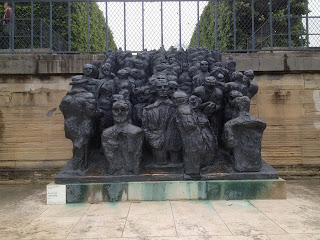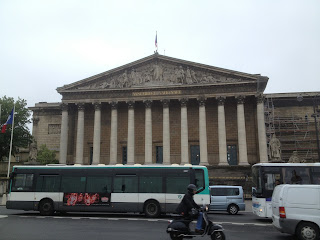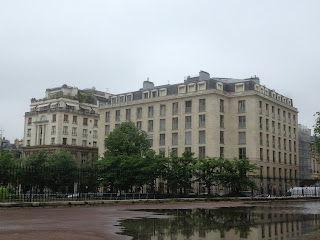In the morning I installed my work in Noisy, and then I took the train into Paris and spend the day walking around. I walked around the Louvre which was closed on Tuesday and then went over to the Eiffel Tower. After the Eiffel Tower, I took a boat tour on the river and then walked back to the train. My hip was bothering me when I went up the tower!! Damn arthritis... suck! The weather has been cool and rainy... around the 50's.
This is in Noisy... you see people carrying around bread for their lunches.
On the train to Paris... the Eiffel Tower is in the background.
The Madeleine Church was designed in its present form as a temple to the glory of Napoleon's army. To its south lies the Place de la Concorde, to the east is the Place Vendôme, and to the west L'église Saint-Augustin.
The Luxor Obelisk is a 23 metre (75 ft) high Egyptian obelisk standing at the center of the Place de la Concorde in Paris, France. It was originally located at the entrance to Luxor Temple, in Egypt.
The beginning of my walk out in front of the Louvre.
Jean Philippe Arthur Dubuffet (31 July 1901 – 12 May 1985) was a French painter and sculptor.
His idealistic approach to aesthetics embraced so called "low art" and
eschewed traditional standards of beauty in favor of what he believed to
be a more authentic and humanistic approach to image-making.
The museum is housed in the Louvre Palace (Palais du Louvre) which began as a fortress built in the late 12th century under Philip II. Remnants of the fortress are visible in the basement of the museum. The building was extended many times to form the present Louvre Palace. In 1682, Louis XIV chose the Palace of Versailles for his household, leaving the Louvre primarily as a place to display the royal collection, including, from 1692, a collection of antique sculpture.[6] In 1692, the building was occupied by the Académie des Inscriptions et Belles Lettres and the Académie Royale de Peinture et de Sculpture, which in 1699 held the first of a series of salons. The Académie remained at the Louvre for 100 years.[7] During the French Revolution, the National Assembly decreed that the Louvre should be used as a museum, to display the nation's masterpieces.
The museum opened on 10 August 1793 with an exhibition of 537 paintings, the majority of the works being royal and confiscated church property. Because of structural problems with the building, the museum was closed in 1796 until 1801. The size of the collection increased under Napoleon and the museum was renamed the Musée Napoléon. After the defeat of Napoleon at Waterloo, many works seized by his armies were returned to their original owners. The collection was further increased during the reigns of Louis XVIII and Charles X, and during the Second French Empire the museum gained 20,000 pieces. Holdings have grown steadily through donations and gifts since the Third Republic. As of 2008, the collection is divided among eight curatorial departments: Egyptian Antiquities; Near Eastern Antiquities; Greek, Etruscan, and Roman Antiquities; Islamic Art; Sculpture; Decorative Arts; Paintings; Prints and Drawings.
A statue of Thomas Jefferson.
The Pont Alexandre III is an arch bridge that spans the Seine, connecting the Champs-Élysées quarter and the Invalides and Eiffel Tower quarter, widely regarded as the most ornate, extravagant bridge in Paris. It is classified as a historical monument.
The bridge, with its exuberant Art Nouveau lamps, cherubs, nymphs and winged horses at either end, was built between 1896 and 1900. It is named after Tsar Alexander III, who had concluded the Franco-Russian Alliance in 1892. His son Nicholas II laid the foundation stone in October 1896. The style of the bridge reflects that of the Grand Palais, to which it leads on the right bank.
The Musée de l'Armée (Army Museum) is a national military museum of France.
The Eiffel Tower is an iron lattice tower located on the Champ de Mars in Paris, named after the engineer Gustave Eiffel, whose company designed and built the tower. Erected in 1889 as the entrance arch to the 1889 World's Fair, it has become both a global cultural icon of France and one of the most recognizable structures in the world. The tower is the tallest structure in Paris[10] and the most-visited paid monument in the world; 7.1 million people ascended it in 2011. The third level observatory's upper platform is at 915.7 ft (279.1 m) the highest accessible to the public in the European Union. The tower received its 250 millionth visitor in 2010.
The tower stands 1,063 feet (324 m) tall, about the same height as a 100-story building. During its construction, the Eiffel Tower surpassed the Washington Monument to assume the title of the tallest man-made structure in the world, a title it held for 41 years, until the Chrysler Building in New York City was built in 1930. Because of the addition, in 1957, of the antenna atop the Eiffel Tower, it is now taller than the Chrysler Building. Not including broadcast antennas, it is the second-tallest structure in France, after the Millau Viaduct.
The tower has three levels for visitors. Tickets can be purchased to ascend, by stairs or lift (elevator), to the first and second levels. The walk from ground level to the first level is over 300 steps, as is the walk from the first to the second level. The third and highest level is accessible only by lift—stairs do exist but are usually closed to the public. The first and second levels have restaurants.
The tower has become the most prominent symbol of both Paris and France, often in the establishing shot of films set in the city.
Made it to the second level... hip was messed up and it was a cloudy day.
















































No comments:
Post a Comment